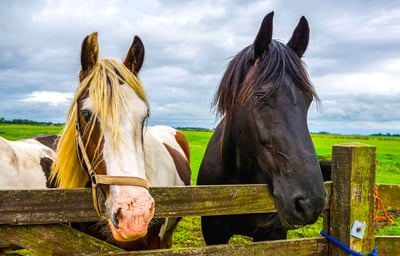Floyd Fain
September 07, 2017 With fall just around the corner, it’s time to prepare for winter horsekeeping and address the issue of seasonal allergies.
With fall just around the corner, it’s time to prepare for winter horsekeeping and address the issue of seasonal allergies.
Budding plants bring pollen, fresh new grass can contain extra sugar or enzymes, and insects pose a risk to many horses. Allergic responses can take several forms, so knowing what to watch for is key to your horse’s health and comfort.
Common Causes
- Insects – think of the usual suspects in your field
- Newly grown pollen from trees and weeds
- Dust and mold (including mold on hay)
- Grooming products like sprays or shampoo
- Stall bedding, particularly if you’ve changed it recently
- Synthetics like those found in bell boots or saddle pads
The Symptoms To Watch For:
- Coughing, sneezing, running nose, dripping eyes or shaking head are symptoms typical of seasonal respiratory allergies triggered by dust, mold and pollen in the field or even in the barn.
- Hives, bumps, rashes, or itchy/irritated skin conditions are often attributed to bugs of all species. In fact, according to veterinarian Stephen White in a Practical Horseman article, insect bites, particularly those from the Culicoides (known to most of us as the pesky “no-see-ums”) are likely the most common culprit in skin reactions. Other insects to watch out for are bees, hornets, mosquitoes and the classic, dreaded horsefly.
- Wheezing or other breathing difficulty, depending on its severity, can be a common allergic reaction or one that escalates into an anaphylactic reaction, which is a severe condition that may lead to shock. A horse approaching shock, notes equimed, “will appear anxious or agitated, have low or no urine output, may have diarrhea, have a rapid, but weak pulse accompanied by shallow breathing, will sweat profusely and show signs of confusion.” Call the vet immediately.
Fighting Off Allergens
If your horse exhibits reactions, your first course of action is a vet visit to determine whether it is an allergy or some other condition, such as rain rot, a reaction to vaccination, or even oncoming strangles.
If you choose a course of allergy testing, says Practical Horseman, “here's what to expect: Your horse is sedated, and an area of skin (usually on the neck) is shaved. Then small amounts of different allergens are injected into the skin, just far enough apart so that any reactions won't overlap.
The injection sites are evaluated at intervals--typically 15 to 30 minutes, four to six hours and 24 hours--and the reactions are scored." The cost could run to the hundreds of dollars, but an accurate diagnosis and treatment plan delivers priceless peace of mind.
If the suspect is food, “ diagnosis is typically made by exclusion,” notes The Horse. “The hay is changed to a type that has not been previously fed, and all grains, additives, supplements, and treats are discontinued. Once the skin condition improves, the products are re-introduced one at a time to try and pinpoint the cause.”
Commercial antihistamine supplements include brands like AniHist H, Hist EQ Powder, HistaGranules and HistALL.
And to ward off insect attacks, owners often turn to bug repellent and flysheets and fly masks.
Sheets designed for hot-weather use are generally breathable, but check your horse for signs of sweating in severe conditions.
Remember to take care of your arena footing as we approach the season of thunderstorms and snow. Our Arena Footing Guide will help you maintain your arena for years to come.

